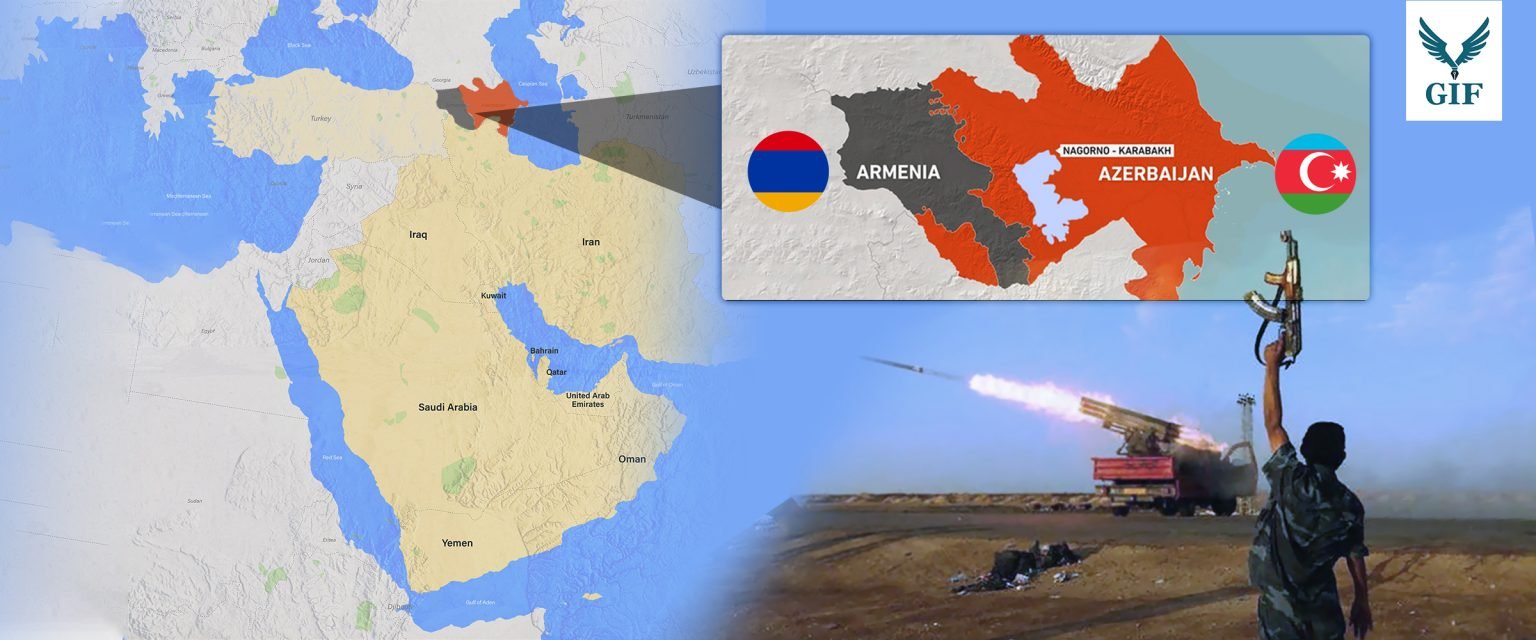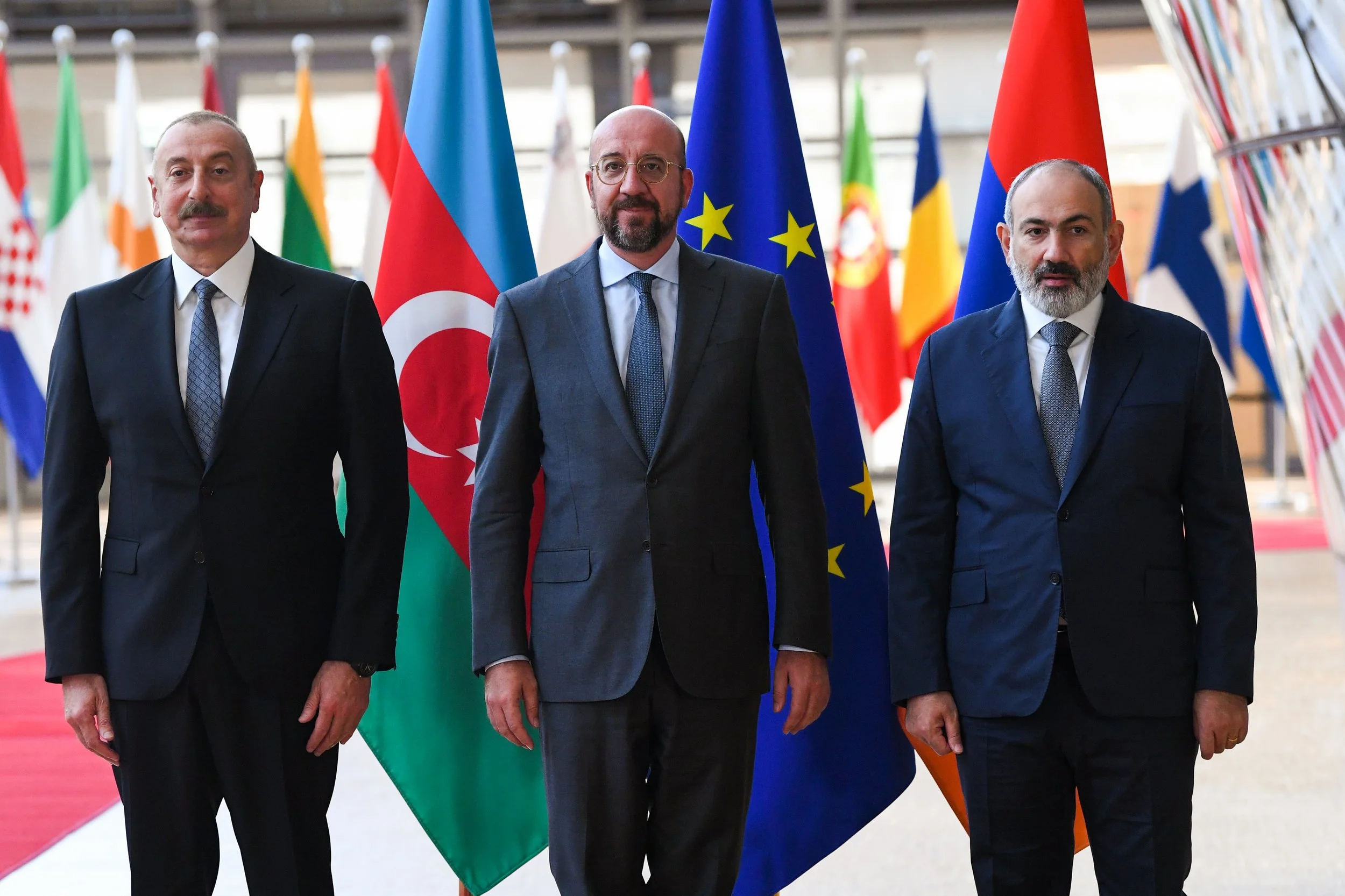The Forgotten War: What is the EU Doing for Nagorno-Karabakh?
By Sara Saccon, 7 minutes
The current conflict between Armenia and Azerbaijan in the contested region of Nagorno Karabakh has always involved Russia and Turkey as main protagonists, respectively supporting a different side and trying to mediate in this war that has now lasted 30 years. But the scenario is changing and recently the European Union seems to exercise a new role in the region. Therefore, this begs the question: how and why is the EU involved in the often-forgotten conflict in Nagorno-Karabakh?
Copyright: Gulf International Forum. Map of the region in which Nagorno Karabakh is located.
https://gulfif.org/nagorno-karabakh-conflict-and-gulf-states-stakes/
In the past months, we have sadly gotten used to finding the word war on almost every front page of European newspapers. The tragic events happening on the doorstep of Europe are getting all our attention and concern, shedding light on how fragile the context of peace in which we grew up in is. We find ourselves forced to reflect on how aware we are of the conflicts taking place around the world, and even more of those going on near the EU borders. With this article, we zoom in on a delicate and sometimes forgotten situation, taking place in Nagorno Karabakh.
How the conflict in Nagorno Karabakh began and evolved
In a region roughly twice the size of the province of Limburg, a war with varying intensities has been going on for about 30 years. Yet, probably the majority of European citizens could hardly indicate on a map where Nagorno Karabakh is and tell what is happening in this region in the South Caucasus, that curiously means “mountainous black garden”. European mass media tend to not give much space to the vicissitudes that involve this small area, which is internationally considered as part of Azerbaijan but disputed with Armenia. Indeed, Nagorno Karabakh is de facto an independent state, named “Republic of Artsakh” and represents a typical case of contested statehood in a region that was previously under the control of the Soviet Union. In order to better understand the current dispute, a review of the historical background is the necessary starting point.
First Nagorno Karabakh War
The Nagorno-Karabakh Autonomous Oblast was established already in 1923 by the Soviet Union within the Azerbaijan Soviet Socialist Republic. Despite its geographical position, it was home to a 95 per cent ethnically Armenian population. Before the dissolution of the Soviet Union, Nagorno Krabakh’s regional legislature passed a resolution declaring its intention to join the Republic of Armenia. This took place in 1988, but the ethnic tensions between Azerbaijanis and Armenians are a centuries-old history. The Soviet Union managed to somehow keep the situation under control, however, after its breakup, all the accumulated tensions resulted in an armed conflict between the two republics for the control of the region.
In fact, as Armenia and Azerbaijan achieved statehood due to the collapse of the Soviet Union, Nagorno Karabakh declared its independence and the situation violently escalated. This first phase of the conflict in the first half of the 1990s caused the death of 30 thousand people and created hundreds of thousands of refugees. This phase, which is known as the “First Nagorno Karabakh War”, ended in 1994 with a Russian-brokered ceasefire called Bishkek Protocol. Armenia gained control of the region, but this protocol was not a peace treaty, therefore the situation was left in a state of legal limbo. The Republic of Artsakh remained de facto independent but internationally unrecognised.
Recent events
The bilateral acceptance of the ceasefire formally remained in force until September 2020, but the situation was so unstable that clashes never completely stopped. Attack drones, shelling, special operations activities, and significant breach of the ceasefire continued for over twenty years, while all the attempts of signing a peace treaty failed.
In September 2020 the situation escalated again with heavy fighting along the Azerbaijan-Nagorno Karabakh border. The Second Nagorno Karabakh War resulted in the death of more than seven thousand soldiers and civilians. After six weeks of a full-fledged war, on November 9th, Russia brokered a deal. Azerbaijan reclaimed most of the territory it lost two decades prior leaving Armenia with only a portion of Karabakh.
In the last two years, not much has changed: a peace treaty still appears to be a distant option and the failure of mediation efforts leads to an increased risk of other military conflicts. Last September the ceasefire was once again violated, and a two-day conflict resulted in additional victims. Even more recently, on the 10th of November, Armenia’s Defense Ministry reported that an Armenian soldier died after being critically wounded in a firefight.
Old and new actors: what is the EU doing?
The duration of this conflict and its underlying political, cultural, religious, and economic implications make it a very complex issue, and in recent years, also the academic community has been busy analyzing its characteristics. What is interesting and relevant to observe in order to have a better understanding of the recent developments are the external actors that are playing a role in this context and how they exercise influence with the instruments they have.
As stated before, territorial disputes remain intractable, but ceasefires have been successfully negotiated since 1994 thanks to the leading role of the Minsk Group of the Organization for Security and Cooperation in Europe (OSCE). The Minsk Group is co-chaired by the United States, France and Russia. But the two external key actors involved in the region have always been Russia and Turkey: Moscow is committed by treaty to defend Armenia in the instance of a military offence, while Turkey has expressed its support to Azerbaijan. It is important to underline that the Second Nagorno Karabakh War ended with Russian peacekeeping forces being brought into the contested region.
In past years, the presence of the EU in the mediation process was in fact limited due to many aspects. For example, the EU never managed to take France’s place in the Minsk Group. Moreover, before these recent developments, Armenia and Azerbaijan never requested the intervention of the EU.
However, many journalists and observers have noted how Russia’s role in the peace negotiation has been gradually weakening in recent months. The Kremlin is in fact experiencing defeat on the battlefield in Ukraine and therefore it seems to represent a less credible and convincing mediator. These changes could represent a new opportunity for the European Union to promote the negotiation process and gain new, prominent role.
Copyright: European Union. From left to right: Ilham ALIYEV (President of the Republic of Azerbaijan), Charles MICHEL (President of the European Council), Nikol PASHINYAN (Prime Minister of the Republic of Armenia).
Two events mark the new involvement of the EU. Firstly, already during the last summer, after another crisis along the border between Armenia and Azerbaijan, the President of the European Council Charles Michel organized various meetings in Brussels with both the leaders of Armenia and Azerbaijan to discuss the mediation talks. Secondly, during the European Political Community summit in Prague in early October, the leaders of the two countries agreed to send a mission of EU observers to their borders.
On its side, Moscow attempted to regain initiative in late October: Russian President Vladimir Putin hosted the leaders of Armenia and Azerbaijan in Sochi, but the summit yielded little. Interestingly, the author Sébastien Boussois points out how: “Against Europe, Putin wants to wield arms and words, war and diplomacy at the same time” (to read the entire article click here).
Copyright: European Union. Event: Meeting of the European Political Community - October 2022
https://newsroom.consilium.europa.eu/photos?keywords=armenia
Future perspectives
It is still too early to predict the consequences of this new involvement of the EU in this phase of the negotiations, and what is evident is that the scope of mediating actors is to bring stability to a region that for so many years has been the center of violent disputes.
Still, even under a more European mediation, there is no guarantee that a peace treaty will be signed, since the conflicting parties have very different concepts for the region's future, and there is a mutual lack of trust. Yet, it will be interesting to observe if and how the European Union will be effective in exercising this new role in this delicate situation. Finally, this could be an opportunity for European media to increase awareness about this ongoing armed conflict. After all, we are not just talking about a region twice the size of Limburg: if you were born in Nagorno Karabakh after 1990 you do not know what life without war is like.
To learn more about this topic and the sources that have been used for this article:
How the West Managed to Sideline Russia in Mediating the Nagorno-Karabakh Conflict
Armenia, Azerbaijan leaders to hold EU-mediated talks




